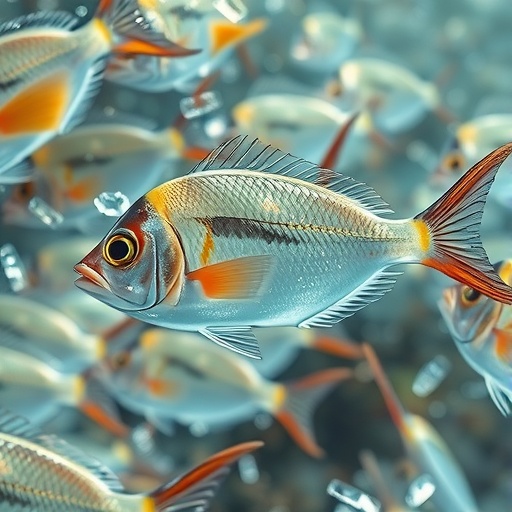Recent research has illuminated a troubling dimension of marine pollution: microplastics infiltrating the bodies of commercial fish within the Arabian Sea. Conducted by a team of researchers led by Khan, N.S., this pivotal investigation provides a sobering snapshot of environmental degradation and its direct consequences on aquatic life. As microplastics have become pervasive in marine ecosystems globally, understanding their accumulation in fish is critical for assessing food safety and ecological health. This study underscores a crucial intersection between environmental science, marine biology, and public health.
The Arabian Sea, a vibrant body of water teeming with biodiversity, has increasingly become a site of concern regarding pollution. As industrial activities and urban runoff introduce vast quantities of plastic waste, the subsequent fragmentation of these materials into microplastics has emerged as an alarming phenomenon. Microplastics, typically defined as plastic particles less than five millimeters in size, have entered marine ecosystems, presenting both ecological and health risks. This pioneering pilot study specifically targets two commercially significant fish species, aiming to uncover the extent of microplastic contamination within their tissues.
Khan and colleagues meticulously collected samples from these fish species in the Arabian Sea, employing a systematic approach to ensure accuracy and reliability in their findings. Each sample underwent rigorous processing to identify and quantify the microplastics present. By utilizing advanced analytical techniques such as Fourier-transform infrared spectroscopy (FTIR), the team was able to classify the types of microplastics present in the fish, providing insights into the sources of pollution affecting the marine environment. This level of detail is critical for understanding the broader implications of microplastic exposure on marine food webs and human health.
Early results from the study revealed concerning levels of microplastic contamination in both fish species analyzed. The presence of these particles raises pressing questions about the implications for marine life and the potential transfer of microplastics up the food chain. As fish consume smaller prey, they inadvertently ingest microplastics, which may accumulate in their bodies over time. The ramifications of this accumulation extend beyond individual organisms; it poses a risk to predators higher in the food chain, including humans, who rely on fish as a dietary staple.
The authors emphasize the importance of understanding how microplastics can affect fish physiology and behavior. Preliminary findings suggest that ingestion of microplastics may alter feeding patterns and reduce overall fitness in fish populations. Additionally, there is growing concern regarding the associated toxicological effects, as these tiny particles may leach harmful chemicals into the fish tissues. The bioaccumulation of microplastics and associated toxins could represent serious public health risks for those consuming affected fish.
As the scientific community grapples with the implications of microplastic pollution, this study serves as a critical alarm bell. It highlights the urgent need for enhanced monitoring of microplastics across marine environments, particularly in regions like the Arabian Sea that are critical for biodiversity and human livelihoods. The findings call for collaborative efforts between scientists, policymakers, and the fishing industry to develop strategies aimed at mitigating plastic waste and protecting marine ecosystems.
Public awareness of microplastic pollution is steadily increasing, yet there remains a significant gap in understanding its implications. This research not only enriches our knowledge of microplastic dynamics in marine ecosystems but also serves to galvanize public interest and action toward reducing plastic use. It is essential to advocate for sustainable practices that minimize plastic production and disposal, encouraging lifestyle changes that prioritize environmental health.
The study also raises significant questions regarding regulatory measures and existing policies on plastic use. Governments worldwide have begun to recognize the urgency of addressing plastic pollution; however, implementation of effective regulations presents a formidable challenge. The findings from Khan et al. could provide valuable evidence to support stricter regulations surrounding plastic production and disposal, catalyzing policy changes that prioritize ecological preservation.
Moreover, this work sets the stage for future research endeavors. As scientists continue to uncover the extent of microplastic contamination in marine life worldwide, comprehensive studies will be essential for documenting trends and establishing long-term monitoring programs. Understanding the movement of microplastics through various aquatic ecosystems will enhance our capacity to predict their impacts on marine life and the overall environment.
As this research gains visibility, it has the potential to spark conversations not just within academic circles but also among consumers, businesses, and policymakers. By translating complex scientific findings into accessible narratives, there is an opportunity to foster greater public understanding and responsibility when it comes to plastic consumption.
The implications of microplastic contamination extend beyond ecological concerns; they intersect with broader societal issues such as health, economic sustainability, and food security. Thus, addressing microplastics in marine environments is not simply an environmental issue but a multifaceted challenge that demands comprehensive and collaborative solutions at all levels of society.
In conclusion, the pilot study led by Khan, N.S. and colleagues represents a vital step in the ongoing battle against plastic pollution in our oceans. The findings shed light on the pervasive presence of microplastics in commercially important fish species, raising urgent questions about the health of marine ecosystems and our own safety as consumers. Continued research, public engagement, and legislative action will be essential in combating this global crisis and protecting the future of our oceans.
Subject of Research: Microplastics in Commercial Marine Fish Species from the Arabian Sea
Article Title: Microplastics in two commercial marine fish species: A pilot study from the Arabian Sea.
Article References:
Khan, N.S., Sultan, I.N., Tareen, A.K. et al. Microplastics in two commercial marine fish species: A pilot study from the Arabian Sea.
Environ Monit Assess 197, 1247 (2025). https://doi.org/10.1007/s10661-025-14696-x
Image Credits: AI Generated
DOI:
Keywords: Microplastics, Arabian Sea, marine fish, pollution, ecological health, food safety, environmental science.




